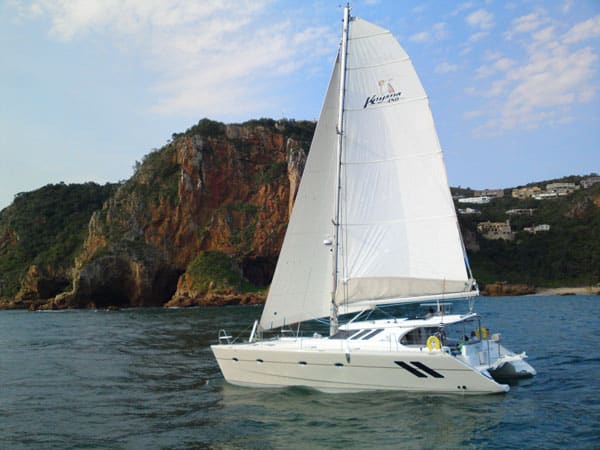
Built in South Africa in the town for which the company is named, the Knysna 480 is a sleek-looking cat, with a low-slung, forward-sloping cabin house located amidships and a roofline that continues aft as a hard bimini over the cockpit. Raked bows, reverse transoms, and chines running nearly the length of both hulls all contribute to the boat’s good looks (see the complete photo gallery here).
The 480 is designed by Angelo Lavranos. A relatively new name to American markets, the Knysna Yacht Co. is closing in on its 70th catamaran since 2002; it builds both the 480 and the Knysna 440.
When you climb aboard from the stern, two steps take you to the bridgedeck, where you enter the cockpit and pass an outdoor dining/cocktail area to port. The Edson wheel with hydraulic steering is mounted on the bulkhead to starboard, with a raised helm seat and an opening overhead in the bimini. When the boat is under way, the skipper sits with head and shoulders above the coach roof and under an optional hard dodger.
In a bit more than 8 knots of wind and on flat water on Miami’s Biscayne Bay, we sailed closehauled at about 5 knots. Unfortunately, the wind slackened as we bore off to a reach, and so did our speed. From the helm, I found the visibility about the boat to be good, but the hard dodger made it difficult to see and trim the mainsail, and there was no easy way to step to the side deck to get a better view aloft. Since then, the builder has added a window overhead. I also found the winch setup on the boat in Miami to be awkward; it had the port winch atop the coachroof on the port side, which meant one had to leave the helm and cross the boat to tack. The owner, for the record, said it hadn’t been a problem in all the miles he’d sailed, since when cruising, one tends to rely on the autopilot. The company notes that in later models, both primary electric winches have been mounted near the helm.
To save weight, Knysna makes ample use of Airex foam coaring in the hulls, deck, and bulkheads. Components are hand laid and vacuum bagged using isophthalic gelcoat and vinylester resin. The interior of the boat we sailed was bright and attractive, with pear veneer laminates and cherry trim. With four cabins and three heads, this boat was intended for a private owner. The charter version has four en suite heads.
A galley-down version is available, as are other layouts, but the boat in Miami had its galley up and to port, with a rear-facing nav station aft. A large, L-shaped couch and table were to starboard. Below, in the hulls, fore and aft cabins featured athwartship queen berths. The en suite heads forward each had quite ample separate showers that also provided access to lockers in the bows. A genset was hidden away in the port bow.
Motoring, twin 40-horsepower Yanmars and saildrives pushed us right along at 7.5 knots in cruise mode and a bit over 10 knots when the throttle was wide open (54 horsepower engines are now available).
Given the 480s transatlantic delivery and trip north from the Caribbean, there was no doubting the boat’s bluewater pedigree.








